Toyota Avensis test drive 1997 - 2000 sedan
Goodbye, Carina
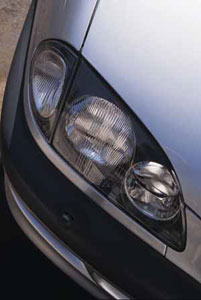 In the middle of last year, Toyota Motor Corporation announced the end of the development and the launch of a new middle -class car in the production of a new car. Against the backdrop of a showdown from Mercedes A-class, anticipation of the phenomenon of the peoples of the new Rolls-Royce and the revival of the Maybach brand, this information was almost unnoticed. What to be surprised? One of the largest world manufacturers, having thirteen series of cars in the range (not counting SUVs), built another model. So what? They appreciated the news in January, at the premiere in Brussels. The novelty, called Avensis, will be produced instead of the legendary Toyota Carina. The forty -year -old story of one of the most popular Japanese models ended.
In the middle of last year, Toyota Motor Corporation announced the end of the development and the launch of a new middle -class car in the production of a new car. Against the backdrop of a showdown from Mercedes A-class, anticipation of the phenomenon of the peoples of the new Rolls-Royce and the revival of the Maybach brand, this information was almost unnoticed. What to be surprised? One of the largest world manufacturers, having thirteen series of cars in the range (not counting SUVs), built another model. So what? They appreciated the news in January, at the premiere in Brussels. The novelty, called Avensis, will be produced instead of the legendary Toyota Carina. The forty -year -old story of one of the most popular Japanese models ended. 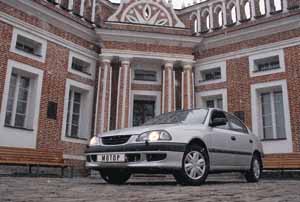 Created in 1957, Carina went through seven radical modifications, not counting the annual restyling, and since 1970 it was produced in general in three versions - for the Japanese, European and American markets. Several generations of motorists around the world managed to grow up, grow up and grow old with these machines. In the process of evolution, Carina increased by 60 cm in length and threefold in power. Never that was a star of the first magnitude on the catwalks of the largest car dealerships, Carina nevertheless earned a reputation as a well -made and unpretentious workhorse. Now the name known to the world becomes part of the story ... Everyone, Carina nameplate will no longer stamp the press.
Created in 1957, Carina went through seven radical modifications, not counting the annual restyling, and since 1970 it was produced in general in three versions - for the Japanese, European and American markets. Several generations of motorists around the world managed to grow up, grow up and grow old with these machines. In the process of evolution, Carina increased by 60 cm in length and threefold in power. Never that was a star of the first magnitude on the catwalks of the largest car dealerships, Carina nevertheless earned a reputation as a well -made and unpretentious workhorse. Now the name known to the world becomes part of the story ... Everyone, Carina nameplate will no longer stamp the press.  In favor of renaming, manufacturers put forward two main arguments. The first is the same name, being heard for 40 years, contributes to the perception of the model as a kind of anachronism. The second - the changes in the design are so deep that Avensis has nothing to do with the ancestor except a market niche. The first statement can be agreed (we will not talk here about the importance of traditions and reputations). With the second I want to figure out: will the Japanese cunning?
In favor of renaming, manufacturers put forward two main arguments. The first is the same name, being heard for 40 years, contributes to the perception of the model as a kind of anachronism. The second - the changes in the design are so deep that Avensis has nothing to do with the ancestor except a market niche. The first statement can be agreed (we will not talk here about the importance of traditions and reputations). With the second I want to figure out: will the Japanese cunning? 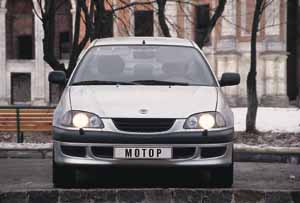 The Avensis body can be three types - sedan, liftback (hatchback) and station wagon, the last two - 5 -door. In each case, there are two varieties of interior decoration and configuration - basic and luxury. For Russia and the CIS, four engine options are provided. The first two are 1.6 liters of 16-valve engines that differ from each other only 3 nm of torque and the presence of a catalytic neutralizer. They are equipped only with a mechanical box and installed on the Linea Terra basic configuration sedans. More powerful 2 l 16 -valve gasoline motors with mechanical or automatic boxes for the entire range of luxury version of Linea Sol. And finally, 2 l 8-valve diesel engines with mechanical boxes are put only on Linea Terra sedans. (For Western Europe, a 16-valve engine with a volume of 1.8 liters is also prepared, which works on a re-glowed mixture.)
The Avensis body can be three types - sedan, liftback (hatchback) and station wagon, the last two - 5 -door. In each case, there are two varieties of interior decoration and configuration - basic and luxury. For Russia and the CIS, four engine options are provided. The first two are 1.6 liters of 16-valve engines that differ from each other only 3 nm of torque and the presence of a catalytic neutralizer. They are equipped only with a mechanical box and installed on the Linea Terra basic configuration sedans. More powerful 2 l 16 -valve gasoline motors with mechanical or automatic boxes for the entire range of luxury version of Linea Sol. And finally, 2 l 8-valve diesel engines with mechanical boxes are put only on Linea Terra sedans. (For Western Europe, a 16-valve engine with a volume of 1.8 liters is also prepared, which works on a re-glowed mixture.) 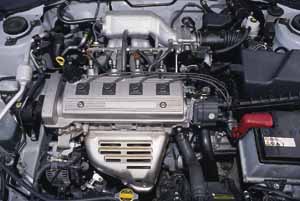 For the test, we took a sedan with a mechanical gearbox and 1.6 liters of an engine without a neutralizer. The choice was dictated by the fact that last year (Motor E18) we experienced Toyota Carina E with a similar power unit: it will be easier to understand what has changed in the car.
For the test, we took a sedan with a mechanical gearbox and 1.6 liters of an engine without a neutralizer. The choice was dictated by the fact that last year (Motor E18) we experienced Toyota Carina E with a similar power unit: it will be easier to understand what has changed in the car. To begin with, let's compare the technical characteristics specified in the accompanying documents. Comple 4A-Fe-Fe-Fe-Fe-Fe-Fe-Fe-Fe-Feature Cub. It is installed on both cars, but in Avensis its power is increased by 4 hp, and torque by 9 Nm. The engine control is completely given to the redemption of electronics, even the throttle drive is electric.
Carina has more external dimensions, and Avensis has a wheelbase and track. This favorably affected the stability and internal space of the machine. Other indicators differ insignificantly, so it does not follow from technical data at all that we are dealing with a new car.
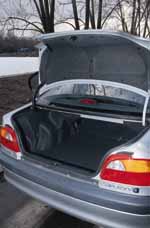 The next stage is appearance, style. At first glance, the models are very similar. The sides of the body, the falling line of the rear rack, glass, smoothly flowing into the lid of the trunk, both cars are the same, but Avensis looks more dynamic, more collected and fried than the amorphous Carina. This is due to a more clearly formed waist line and the absence of hollow translasts on the doors. Lasted blocks work for the swiftness of the appearance (well prominent, even if you look at the car from the side), and the radiator cladding is the continuation of the hood.
The next stage is appearance, style. At first glance, the models are very similar. The sides of the body, the falling line of the rear rack, glass, smoothly flowing into the lid of the trunk, both cars are the same, but Avensis looks more dynamic, more collected and fried than the amorphous Carina. This is due to a more clearly formed waist line and the absence of hollow translasts on the doors. Lasted blocks work for the swiftness of the appearance (well prominent, even if you look at the car from the side), and the radiator cladding is the continuation of the hood. 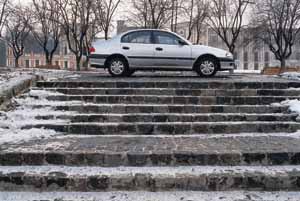 The most significant alterations in the back, which allow you to immediately distinguish Avensis from Carina, belong to the back panel. The design of the new car was developed by the European Bureau Toyota, taking into account European fashion. So it is no coincidence that Avensis is a stern on the BMW of the 3rd series (dictating style in this class), and, accordingly, on Nissan Primera, the back of which was also made with an eye on the German model. However, the appearance of the car only benefited from this, and it is not shameful to copy good style.
The most significant alterations in the back, which allow you to immediately distinguish Avensis from Carina, belong to the back panel. The design of the new car was developed by the European Bureau Toyota, taking into account European fashion. So it is no coincidence that Avensis is a stern on the BMW of the 3rd series (dictating style in this class), and, accordingly, on Nissan Primera, the back of which was also made with an eye on the German model. However, the appearance of the car only benefited from this, and it is not shameful to copy good style. In general, despite significant changes in the back, the old and new models have much in common, family resemblance is clearly traced. In this case, the continuity of style is both good and at the same time bad. Well because the car is recognizable. And it’s bad because, despite a more lively and original design, it, like Carina, is quite boring in appearance and is clearly inferior to the main rivals in the European market - Peugeot 406, Volkswagen Passat and Ford Mondeo.
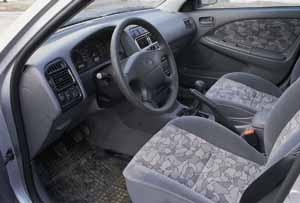 The largest changes occurred in the cabin. The quality of the assembly and decoration of the latter in Carina was very high. Nevertheless, in Avensis it is even higher, and in combination with an increase in the internal volume of the machine, the car interior pulls on the class more sprout. The panels covering the torpedo, the central console and framing the doors began to be made from very pleasant to the touch, soft plastic. The keys that control the electric windows are organically inscribed in the armrests on the doors. The driver's seat is additionally equipped with stiffeners, height, tilt of the pillow and lumbar stops. The gray color of cloth upholstery, a small pile of which contributes to perseverance, will diversify funny strokes. They are not as bright as on the previous model, which also corresponds to a more solid image of the salon.
The largest changes occurred in the cabin. The quality of the assembly and decoration of the latter in Carina was very high. Nevertheless, in Avensis it is even higher, and in combination with an increase in the internal volume of the machine, the car interior pulls on the class more sprout. The panels covering the torpedo, the central console and framing the doors began to be made from very pleasant to the touch, soft plastic. The keys that control the electric windows are organically inscribed in the armrests on the doors. The driver's seat is additionally equipped with stiffeners, height, tilt of the pillow and lumbar stops. The gray color of cloth upholstery, a small pile of which contributes to perseverance, will diversify funny strokes. They are not as bright as on the previous model, which also corresponds to a more solid image of the salon.  The rear passengers received at their disposal a convenient sofa with a profiled back and three head restraints, as well as a hinged central armrest with a built -in box for small things and cup holders. The corresponding dimensions of the doors and openings for both models are the same, but due to the fact that the Avensis wheel arches protrude less in the cabin, landing in the rear seat is now more convenient.
The rear passengers received at their disposal a convenient sofa with a profiled back and three head restraints, as well as a hinged central armrest with a built -in box for small things and cup holders. The corresponding dimensions of the doors and openings for both models are the same, but due to the fact that the Avensis wheel arches protrude less in the cabin, landing in the rear seat is now more convenient. Sound insulation of the cabin is significantly improved. At last year's presentation of the new Corolla, Toyota specialists spoke in detail about the use of the latest noise and vibration-absorbing materials and technologies. In particular, they now fill the internal cavities of the car with foamed polyurethane. Probably, the same methods are used in the production of Avensis. The result is obvious - the engine noise begins to be captured only when the revolutions are exceeded for 4000, and the suspension with the transmission is completely invisible. In addition, in Avensis, pendants are attached to the body through special rubber pillows. So when driving with lowered glasses, the loudest of the sounds heard in the cabin is the rustle of tires, and at high speed - also the noise of the wind ...
The driver’s workplace is organized quite conveniently: the steering wheel - in place, the column is regulated (though only in height), devices in sight, controls - at hand ... it would seem - sit, control and enjoy. But ... did not like two - if I may call them - technical solutions. The first and main disadvantage is the gas pedal: it is located almost twice as lower than the rest, so it is impossible to transfer the foot to the brake in the usual way. In addition, the entire pedal node is slightly shifted to the right, so that it is also impossible to raise the leg vertically upward - the convex side wall of the tunnel in the floor interferes. For braking, it is necessary to make a leg - to move a complex trajectory, which takes time, and it is precious. The shortage is more than strange: after all, the gas pedal does not have a strict connection with the throttle, and it could be placed much more convenient for the driver.
 The second drawback is more annoying than serious. The gearbox lever when the 1st and 2nd gears are turned on, it moves back and forth strictly in the vertical plane, when the 3rd, 4th and even more than the 5th, it deviates more and more to the right-towards the passenger chair-and beyond He, accordingly, has to reach further. Perhaps this is due to the fact that Avensis is designed and produced in the UK, where, as you know, they drive in the oncoming lane. The driver sitting on the right to control the box with such moves of the lever will be quite convenient.
The second drawback is more annoying than serious. The gearbox lever when the 1st and 2nd gears are turned on, it moves back and forth strictly in the vertical plane, when the 3rd, 4th and even more than the 5th, it deviates more and more to the right-towards the passenger chair-and beyond He, accordingly, has to reach further. Perhaps this is due to the fact that Avensis is designed and produced in the UK, where, as you know, they drive in the oncoming lane. The driver sitting on the right to control the box with such moves of the lever will be quite convenient. In the movement, the new Toyota behaves perfectly. Medium -length transmission and 110 hp. Under the hood, they allow you to switch not too often. With a non-stop driving around the city, in principle, you can do the 4th and 5th, and touching traffic lights-only even transmissions. The motor, in full accordance with the smooth curve of the torque, manifests itself best in the range from 3,000 to 5000 revolutions. The red zone on the tachometer begins at 6200 rpm.
 In turns and on different bumps, a new car behaves much better than Carina. The increased base length and track width have favorably affect stability and comfort. Suspension setting - excellent. The praise also deserves steering. The designers took special measures in order to strengthen the driver's attendance of the power of the steering wheel. They succeeded - even at a minimum speed it seems that the steering wheel independently seeks to take its starting position, and when driving a large radius in the bend and even along a profiled road, you steal, you feel the resistance of the steering wheel.
In turns and on different bumps, a new car behaves much better than Carina. The increased base length and track width have favorably affect stability and comfort. Suspension setting - excellent. The praise also deserves steering. The designers took special measures in order to strengthen the driver's attendance of the power of the steering wheel. They succeeded - even at a minimum speed it seems that the steering wheel independently seeks to take its starting position, and when driving a large radius in the bend and even along a profiled road, you steal, you feel the resistance of the steering wheel. Powerful stabilizers do not allow the body to turn hard in corners and do not allow the wheel to hang. The rearrangement from a row in a row at high speed is easy and confident. It seems that the car simply shifts in one direction or another, without changing the direction of movement. It is felt that they worked on the rear suspension ...
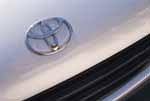 The car is not too strict to the driver and is inclined to forgive him for some mistakes in management. This managed to make sure when the steep turn was held at an unreasonably high speed. At first, a hint followed that the trajectory was chosen incorrectly - the car slightly roared out of the turn, but with increasing engine thrust, obediently returned to the front axle to the desired course, choosing less from two evils - the back of the rear.
The car is not too strict to the driver and is inclined to forgive him for some mistakes in management. This managed to make sure when the steep turn was held at an unreasonably high speed. At first, a hint followed that the trajectory was chosen incorrectly - the car slightly roared out of the turn, but with increasing engine thrust, obediently returned to the front axle to the desired course, choosing less from two evils - the back of the rear. In the end, it was possible to master the complex algorithm for transferring the leg to the brake pedal. Of course, when performing this, time is lost, but you can get used to it, the main thing is to correctly predict the road environment. The car slows down effectively. There was no ABS on the machine provided to us, but even without it, braking took place stably and confidently, even on a heterogeneous coating.
The car was a success. This is a new model or a strongly modernized old one - it doesn’t matter. The main thing is that consumers received a solid and modern car. In terms of technical characteristics and ratio of price-quality Avensis, few of the competitors will yield and, most likely, in any market will be able to repeat the success of Carina. It would be nice for him to add a little individuality ...
Evgeny Romantovsky
Source: Motor magazine [No. 6/1998]
Toyota Avensis Crash Test Video - 2000
Toyota Avensis 1997 test drives - 2000
Toyota Avensis Crash Test 1997 - 2000
Krassh Test: Detailed Information23%
Driver and passengers
16%
Pedestrians









